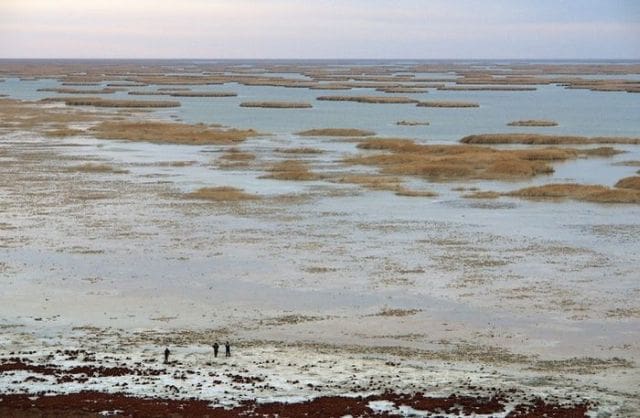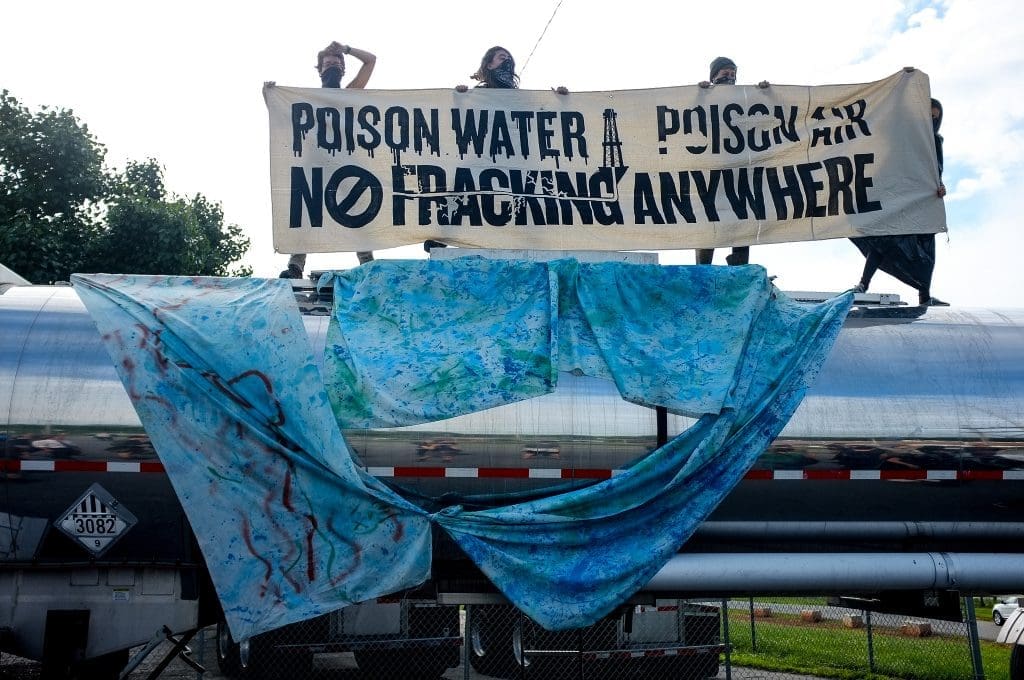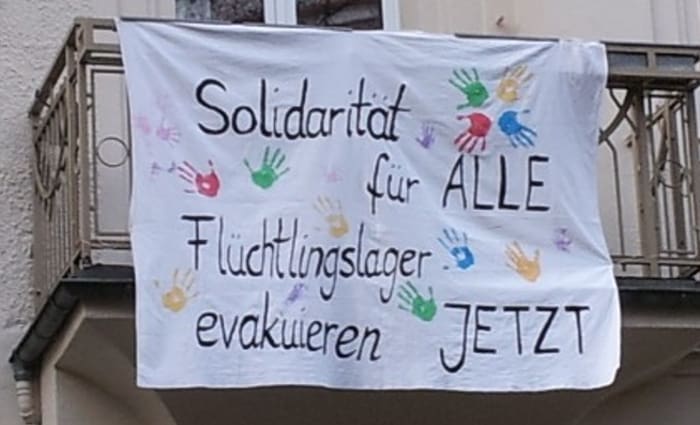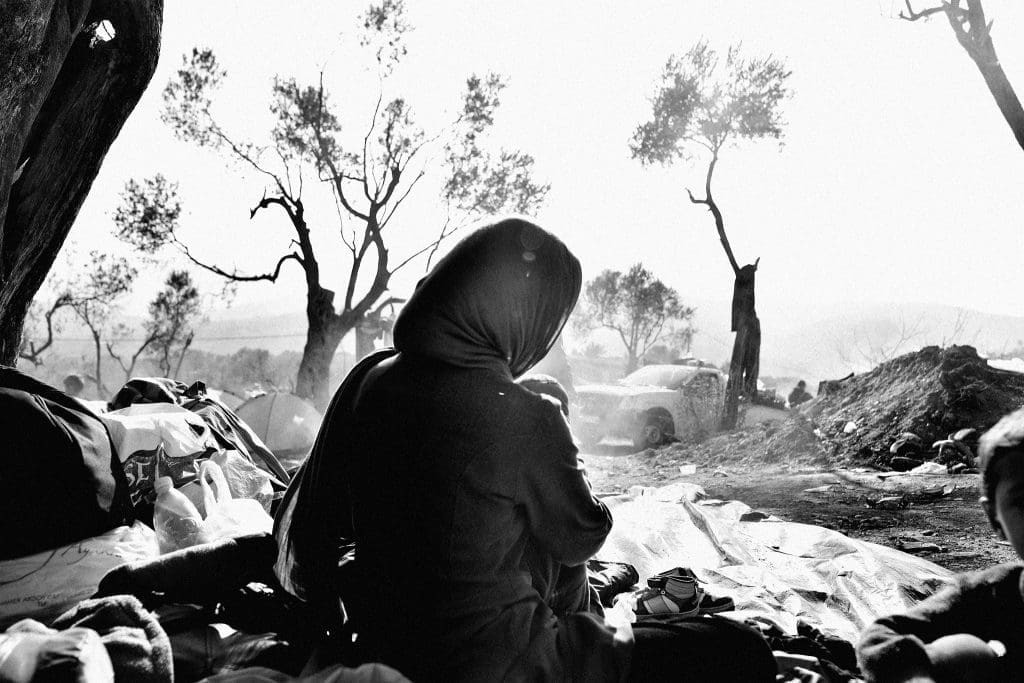Dead Land, Dead Water
Saskia Sassen on loss of habitat and new migrations
This is an unauthorized reproduction, in text form, of a private conference presentation. Edited for space and readability. Full video available in the usual places as well as here, where we first encountered it.
This is just the merest beginning of this new type of flow. This is going to escalate and escalate.
3 May 2016, Berlin
Saskia Sassen: It’s very nice to be here again at re:publica, and I’m delighted that you’re here. What I’m going to be talking about is not as delightful. It is what is happening in the world today, one feature of it, which I want to put under the umbrella of a massive loss of habitat.
There are new migrations that are happening. We are dealing with two familiar subjects in the current migrations: the war refugee and the the migrant. But there is also a third type of migrating subject, for which we lack language. I want to make that third migrant visible.
One way of making that third type of migrant/refugee visible is to ask the question: why are they moving? There is no war where they’re coming from. Why are they moving? Why are they desperate? The umbrella explanation that I want to give is that we’re dealing with a massive loss of habitat due to climate change. And I must tell you, I think climate change is far too pretty a word. So I call it dead land and dead water, which is what we have been making.
The expansion of mining, the expansion of land grabs, the expansion of cities: all of these processes have the capacity to force people off their land—people who may have been on that land for centuries. But they don’t have the papers, they don’t have the instruments to show that “This is my land,” so they can be thrown out. The estimate is that every year, up to three million people are displaced in this manner.
The main point I want to make is that they are invisible to the eye of the law, to any kind of authority. My effort is to make them visible. We’ve got to make them into a subject that is recognizable to existing law, to existing modes of recognizing subjects. Because frankly, this is just the merest beginning of that type of flow. This is going to escalate and escalate.
Now, the refugee is a well-established subject. There is law. There is a regime: UNHCR. It may not work perfectly (it’s imperfect; everything is imperfect), but there is a regime. When refugees appear at our borders, they can be recognized. The law can see them.
The migrant is a very different type of subject. The migrant is a strong subject. She leaves behind a home, a farm, a family, a community. She wants to travel, make money, support that community. The evidence is overwhelming that migrants send a lot of their money back home. She’s strong.
This third subject, that does not exist in the eye of the law, is the victim of forced displacement that happens where there is no war. That is really the challenge, and that is what we need to work at.
Grabbing and Killing Land
Let me start with some images that I think are stunning. I like to say: We made this. Twenty years it took us to get from this Aral Sea [left], one of the biggest internal seas, to this [right].


We must say: that’s a capability. It’s amazing. That did not fall from the sky. We made that. We made that in multiple ways, with a mix of elements. Now, typically the word capability has a positive meaning. I’m not using it in that sense, the Amartya Sen sense. But this is a capability, a negative one. But if we made this, what else can we make that is positive? Can we make new regimes that address some of these issues?
But the other thing is, this is loss of habitat. This was a huge sea. Now it’s a salt field, so there’s a whole new industry that can install itself there. But it has wrecked the communities around it. This is visible history, because the scientists are documenting it. What has happened to those communities? Such a huge sea—there were many, many worlds around that sea. Gone. Where do those people go? This is just one example.
Then there are land grabs. Land grabs have long existed. The United States used a lot of land in Kenya, for instance, to raise cattle, because cattle is quite destructive, as we know. Kenya has vast stretches of dead land thanks to the United States using it to raise cattle. Same thing in Central America. A lot of dead land. So we have been killing land for a while. “But there is so much of it!” Well, it’s shrinking.
The estimate right now is that over 300 million hectares of land have been bought since 2008. Again, think: the big picture here is loss of habitat. People are appearing at our borders—at Europe’s borders, at this moment—partly because there are about a hundred firms and about fifteen governments—that includes the United States, but it also includes Saudi Arabia and China—who are buying land to develop plantation agriculture.
And we know that plantation agriculture is destructive of land. It does not enable land to have earth, to have a long life. Smallholder agriculture knows how to keep land going for millenia. Plantation agriculture, no way. That’s not the point. It’s about pesticides and fertilizers to get it huge, to get it growing fast, and it all has to look beautiful, so there are a whole lot of chemicals. But smallholders—we know this—don’t have documents that say “This is my land; my family has been living here for a century, for three centuries,” so they are easily thrown out.
This happens with the expansion of cities as well. The city just moves in and they are thrown out. Gated communities, office parks. There are about five hundred new developments of this sort that have been built in different parts of the world over the past twenty years. We’re only going to be expanding our cities. I picture this crawling construction apparatus that moves into land that was once held by smallholders. Smallholders, I repeat, know how to care for the land. A city just goes out and covers it all with cement.
We’re all familiar with what’s happening in terms of temperatures. We have much more negative coming. And again: the big picture here is a massive loss of habitat.
This has been happening in Africa, of course, but Europe has also been growing very rapidly. You may not be aware of it, but let me give you a couple examples of land grabs in Europe.
This is something that happened a few years ago: the sons and daughters of former farmers in France, given the bad job situation, decided that maybe the best bet was to go back to the countryside and buy some land, and do some specialized farming. Guess what? No land for sale. It has been mostly bought up by large corporations.
Saudi Arabia and the Qataris have more or less bought Bosnia. Poor farmers are retiring very quickly; they are invited to retire. They are very happy! But the land…
One last example I want to give is England. England has a lot of green land. So a nice Swedish firm—you know this clothes maker, M&H or something like that—has bought a vast stretch of land in northern England. Why? I don’t know. But these are just examples in the Global North. Most of it is happening in Africa, parts of Asia, and parts of Latin America.
Much of this land is going into a mode of agriculture that uses a lot of poisons: growing biofuels. Most people think that most of it is going for food crops—which would be fine, but in the plantation mode not that great. But biofuels are really bad, because since they are growing crops that are not for eating, they have no constraints on the amount of pesticides and chemicals they are using. They are making that land dead.
Now again, I want to remind you: all of this is under the umbrella of a massive loss of habitat. Where these plantations are being developed, in twenty years they wind up with land that is truly degraded. Then they move on to the next spot.
There are also water grabs. There is a lot going around about Nestlé and Coca-cola. They managed to exhaust two underground water tables in particular areas of India—a very highly populated country—which are now without water. They depend on water being trucked in once or twice a week.
Coca-cola and Nestlé are also exhausting water tables in the United States. New York has a huge water reservoir, and Coca-cola just digs into it. They pay almost nothing for it. They pay what we pay for the water, and then they sell it to us, of course. So at one point, the governor told Coca-cola, “Okay, you’re out of here.” In California, the government just discovered that Nestlé was taking out water, and it also told them to get out. But this is happening all over. In the meantime, another governor invited Nestlé to come and take water. In Nevada!
Think about it. This is happening in the United States; this is happening in Northern countries. Imagine how the extraction works in Global South countries. This is extremely serious stuff. And the background story to the killing—the quick killing—of this land is really how it spreads. More and more is getting lost. And more land is also getting killed via other means. So the picture here is a massive loss of habitat.
We’re all familiar with what’s happening in terms of temperatures. The United States has an area that it calls, modestly, the “bread basket of the world.” It is land where there is a lot of farming happening; very effective farming. When you travel through that, it looks either beautiful golden—wheat—or beautiful green, depending on the crop. So it looks alive. But it turns out the temperature of the earth there is getting hotter and hotter; that means it is dying. It is simply dying. One day they are going to wake up and say, “Oops! It’s done.” This has already happened in California. In California, a lot of land is now—officially—dead.
Again, this is the Global North, where supposedly we have less population—certainly in the United States. We don’t have good data for the Global South, but imagine what it is like there. Imagine what it is like in certain parts of India. Imagine what it is like in certain parts of Asia.
Also, water is already limiting agricultural productivity. We have good data on this for North America. But it is certainly everywhere. Again, this is a massive loss of habitat.

And if we look at our current policies—policies, not scientific assertions: if we implemented all the policies that we have sort of agreed on in the world, the purple line there [above] is the little difference it would make—the curve is still sharp. If we don’t implement them, it’s the black line. In other words, we have much more negative coming. And again: the big picture here is a massive loss of habitat.
The Logics of Expulsion and Extraction
There is something about how we have handled the global habitat that has had as one consequence the shrinking of livable space.
I don’t want to use the word imperialism here, but I want to juxtapose what is happening now in the Global South to older imperialisms. When Britain and France and such were the big imperial powers, they came with projects. The French with their famous mission civilisatrice: that all children, no matter where in the colonies, all had to study French and readthe same books as children were reading in France. Then there’s the British officialdom of empire—India is one typical example in the literature of the subaltern. They had big imperial projects.
Today, we still have big powers moving into areas that are not “their” country, but it’s radically different. Using the language of imperialism is not quite enough. We should find other language.
China is a very good example here. China discovered reserves of minerals and metals behind Rio de Janeiro. So it went in, made an agreement with the government. It developed the mine. Then it developed the highway to bring the stuff to a port—that it also built—in order to then take it all back to China. When it is done extracting all of that stuff from the mine (in other words, when the mine is done), it leaves. And it leaves the road and the new port behind. And the hospital for its workers (because they always bring in their own workers).
This is a very different mode. One marking logic common to all the things I’ve discussed so far is the logic of extraction. In my work I also argue that finance, as opposed to traditional banking, has a logic of extraction as well. Extraction means: once you grab it, you’re out of there. You don’t need it. It’s not quite like mass consumption as a dominant logic, where one wants one’s sons and daughters to “do better.”
When we deploy this sort of logic on the whole world, the result is a massive loss of habitat, leading to what we are seeing in Europe: those migrants who are not coming from war zones, and are not part of well-established, long term migrations, but part of that third sector. That third sector is simply moving because they’ve been expelled from their land.
In my current research, I am working on three flows. One is Europe. But I want to talk especially about two other ones which are less known. The kinds of flows that I’m interested in right now are not simply produced by war. War is a massive event, and yes, people have to flee. But this is all more under the vector of loss of habitat—which is also war; there is certainly violence involved.
These flows that I’m going to talk about signal the making of new history, and we should take it seriously. This “third subject” I propose is an emergent subject, and we’re going to see much more of them. And there is—I repeat—no regime that allows us to recognize them and to say, “These are the rights they have, the claims that they want to make.”
Honduras: Violence in the Cities, Violence on the Land
We can’t just simply say it’s the drug dealers. We have to look at how we have wrecked the countryside, how we have wrecked the possibilities of small farmers to survive. We have a plantation economy, and we have cattle raising in Central America. It kills the land.
The first one comes from Central America, buried among all the other flows coming from that region. Both Mexico and the Central American countries—Guatemala, El Salvador, Honduras—have all kinds of migration flows. I single out a migration flow that does not fit the established modes (either war refugee or traditional migrant). And in the case of Central America, the one flow that gets mixed up in all the other flows is unaccompanied children—that means people younger than eighteen (the youngest that we know of is eight) and unaccompanied: without parents, without adults.
We all know the famous migration route coming from Mexico, how tough that can be. Coming from Central America, you first have to deal with getting out of your own country—and these are all countries with an enormous amount of violence—then you have to cross the border into Mexico—tough—and then you have to cross the whole of Mexico, and then you wind up in the desert of the United States, if you are lucky.
These are unaccompanied minors. The United States doesn’t know what to do with these minors; this is new. There is no law for this, no specific regime. They have counted 160,000 arrivals in recent years, all undocumented, all unaccompanied by grown-ups (there are also children coming with their parents; this is just those traveling unaccompanied). This is mind blowing. And you know what? That number is only how many have arrived in the United States. We don’t know how many have died on the way, or have been kidnapped, or are now working on plantations in Mexico. We don’t have the full figures.
No one knows what to do with them, because there’s no regime, really. We know that some of them have been in these makeshift buildings (which are somewhere between prison and non-prison, but more like a prison) for over a year. This is a bit unreal.
Here are some of the figures:

Mexico, for the longest time, was the key source of unaccompanied minors. Look at the other three Central American countries—El Salvador, Guatemala, and Honduras. In 2011 it begins to take off; 2012 more; and then it goes way up.
Notably, after 2014 there is a significant fall [all the way back down to 2011 levels by the beginning of 2016]. You know why (remember, this is merely the number of arrivals in the United States)? Because the United States asked the Mexican police and military (and they gave them money) to stop them at the Mexico’s southern borders with those three countries. Now, the Mexican police are not necessarily known to have a great sense of fairness or care. So this is truly hell. We don’t know how many there are or what happens to them. But it has made an enormous difference in the numbers. There is a lot yet to be told.
Anyway, back to where arrivals in the United States from these three Central American countries take off, back in 2011. What happened? Why, at that moment, does it take off like that? Here is the simplest answer, the answer that the children give themselves: fear. Fear, because these three countries, along with a fourth country that is not in the Americas, are the places with the highest level of killing in cities. Those places have been wrecked by the wars of Central America, very abusive wars; the United States played a very big role. And these kids are afraid. Many of them have lost their parents. They leave out of fear.
I want to examine that further. I accept, one hundred percent, when these kids say, “I’m afraid; I can’t live here anymore.” They are so scared that they are willing to cross Mexico—they are not stupid; they know what it takes. Fear is reason enough. But we have to go back further; this is a theme that recurs in my analysis. I use the same analysis for Africa. What is happening in the places where these people are coming from? That is what we must ask. We cannot just ask, when they appear at our borders, “Hey, show me, what is your legitimation!” We must really begin to ask what is happening in Africa, what is happening in Central America.
Of course, what is happening in Central America is a massive amount of land grabs. A development of mining and a further expansion of already long-dead land. Again, a massive loss of habitat. That then gets intermediated by a drug trade as one mode of making a living, leading to a lot of physical violence in the cities of these countries. But we can’t just simply say it’s the drug dealers. We have to look at how we have wrecked the countryside, how we have wrecked the possibilities of small farmers to survive. We have a plantation economy, and we have cattle raising in Central America. It kills the land. I insist that we must begin to recognize this loss of habitat when we’re dealing with current migrations.
Rohingya Between Expulsion and Slave Labor
This is extreme. This is not simply ongoing migrations. It’s not even the ongoing refugee flows. This is something else. This is of a brutality that is almost inconceivable.
The other migration I am looking at is the Rohingya. As you know, these are Muslims living in a country that is mostly Buddhist, Myanmar. Here is the explanation: some groups, particular sects of the Buddhists—who are normally about peace and love—have gone a bit crazy, and have said that the only way to deal with Muslims is to kill them. This has produced a sudden migration over the last five years.
That is the informal explanation, but it is not the whole explanation. I went there with my lenses on, to check out the loss-of-habitat situation there. Myanmar, as you know, recently opened up its borders to all kinds of investors—the regime changed a bit. And guess what? Massive development of mines (Myanmar is “virgin territory” in terms of the global corporate situation; it has all this amazing stuff that no one has exploited or extracted yet!) and massive land grabs for growing food or bio-fuel.
The crazy Buddhist monks who decided that it’s legitimate to kill the Rohingya are seen as the cause for this migration. No. The cause is very different. It’s that millions—including regular Myanmar people, Buddhists, regular farmers—are being thrown off their land. Brutally. The point that I want to make, again, is that it’s a massive loss of habitat that we see happening there, in the form of using land that used to be for farming, for living on, instead for new purposes that expel people. Millions are being displaced. The Rohingya have become a symbol of something else, but it’s really the wrong explanation. Like with Central America: “Oh, it’s the drug dealers.” No, it’s a much deeper story.
When everybody was talking about the Mediterranean—the ships with floating people, “our” migrants—the same thing was happening in the Andaman Sea. Ships floating, the smugglers who made a business out of it. At one point that same summer in the Andaman, it is estimated that 7,000 people were aboard various ships. Many of these ships had lost power. People were dying. There were women and children who were literally crushed in steerage. This is an amazing story.
Because of these flows of people, there was a bit of attention in the region, and they found all kinds of camps, basically for prison labor, full of Thais and people from Myanmar who were treated as slaves. The Thai fishery industry—a huge sector, a very profitable sector—has long been known to use people like slaves, desperate Thai people who come from the mountains. But here they found more. They found mass graves. Those workers who were too old or too belligerent: they killed them. This is a major issue right now.
I want to repeat something I already said: I am focusing on very specific flows. In that region there are also older, long-established flows. I’m speaking about flows that are emergent, that are new, that are coming out of extreme conditions, that we don’t have good explanations for. Out of that comes this whole question of a loss of habitat.

So here are the trafficking routes, because traffickers are the ultimate intermediary in this whole business. As you can see, Bangladesh is also a source. There are Bangladeshis who are also leaving. And Malaysia is a very important destination, but Indonesia has something like 15,000 islands that are not inhabited, and a lot of stuff is happening there, it turns out, though nobody thinks about those 15,000 islands. One thing that was found was that the big fishing companies have settled some of these islands with their ships and their workers, and they keep the workers in prison camps on them. In Malaysia it has become too visible, so guess what? They occupy some Indonesian islands. 15,000 islands—no government can keep control over that.
These are extreme cases I’m looking at; I’m looking only at extreme cases. I recognize they are extreme cases. But they produce, if you will, a “geography of utility.” These are geographies that are being used, like the Indonesian case that I just mentioned. These are signals of extreme conditions. This is extreme. This is not the ongoing migrations. It’s not even the ongoing refugee flows. This is something else. This is of a brutality that is almost inconceivable.
What Is Being Lost: the Full Meaning of Habitat
I want to begin to conclude. When I speak about a massive loss of habitat, I aim at using the term habitat in its fullness. Habitat is the possibility of living, of making a living—making a living not as in making money; it can be making money, but it can also be making food. Habitat in a thick, beautiful sense.
I didn’t document it fully here, but after having documented it all in my larger writing that I’m busy with, the project really is to generate the possibility of making a subject who is profoundly affected by some of these trends. I’ve just described a few that are extreme ways in which we deal with the larger habitat of the world, starting with the Aral Sea, then the destruction of so much land in Central America. Central America is one of the areas of the world that has the most dead land. More than Africa’s dead land. And that’s from the United States—the plantation model and the cattle raising. That’s not bombing, that’s not war. That’s just an economic mode.
So there is something about how we have handled the global habitat that has had as one consequence the shrinking of livable space. I think I mentioned it already, but the chapter that got me the most riled up in my Expulsions book was the last chapter, which I called “Dead Land, Dead Water.” Because just saying climate change is not enough. It’s too pretty.
We need to develop regimes that, first of all, produce a subject for the eye of the law—indeed, for the eye of the political, but let’s just say at this point the eye of the law, international law—that we can recognize. We have done that for war refugees. Most countries in the world have some version of an immigration policy; we have done it for immigrants. We have not done it for this type of individual who simply has no place to live, because they have been thrown out, because of poisonous land from mining or plantations.
That is my call. If there is one positive that I want to extract from the global migration crisis, it is the discovery of a kind of subject that we have difficulty recognizing. We don’t know what to do with that subject. But what this crisis has given us is these types of migrants telling us about what’s happening where they are coming from. If it’s not war, and it somehow also isn’t that they’ve left behind something good, then what is it? These are migrants for whom home is now a plantation, a mine, it’s covered with water (climate change), it’s desert (climate change), or it’s built up terrain. They are not, as I started out describing, the strong figure who leaves behind something that she wants to keep on contributing to and might go back to. Nor are they war refugees. There are no wars where they are coming from.
So they are falling into a blank, because we have no regime that makes them visible to the law, with which we can recognize them and deal with them.
My call is that we establish one. I thank you very much for your attention.





